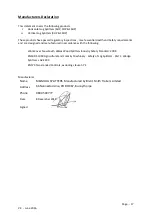
Page ... 13
V4 - June 2016
Log Lift Arm
The Lift Arm mechanism, provided for lifting logs onto the machine, is powered by a separate
hydraulic cylinder. Multiple logs can be placed on the arm for lifting.
Set Up
1.
Disconnect the Hydraulic Cylinder from its Stowage Bracket (Fig E). Remove the Retaining
Clip. Remove the Clevis Pin and position the Cylinder so it can move freely.
2.
Remove the Retaining Clip and disconnect the Lift Arm from its Stowed Position (Fig D).
3.
Lower the Lift Arm
4.
Turn the Engine ON
5.
Connect the Hydraulic Cylinder to the Lift Arm Bracket. Use the Lift Arm Control Lever (Fig B)
to move Hydraulic Cylinder and align the Clevis with the hole on the Lift Arm Bracket
6.
Secure the Hydraulic Cylinder. Insert the Clevis Pin and Retaining Clip (Fig E)
Operation
1.
The Lift Arm Hydraulic Cylinder will only operate when the Engine is running
2.
Place log(s) onto the Lift Arm (Fig A)
3.
Raise and Lower using the Lift Arm Control Lever (Fig B)
Stowage
1.
Disconnect the Hydraulic Cylinder from the Lift Arm Bracket. Remove Retaining Clip and
Clevis Pin (Fig E)
2.
Raise the lift arm into the Stowed Position and secure with the Retaining Clip (Fig D)
3.
Adjust the position of the Hydraulic Cylinder so it can be re-secured to its Stowage Bracket.
Insert Clevis Pin and Retaining Clip (Fig C)
Operator Position
The operator should position themselves facing the two handed controls. This is part of safe use of
the machine as:
1.
It allows for full visual coverage of the hazard zone
2.
It allows the operator to check no one else is at risk of injury
3.
It prevents others from loading logs into the splitting-zone
4.
It ensures the operator's body, hands and limbs are clear of the machine hazards when
operating the controls
5.
It prevents logs from falling onto the lower limbs of the operator or those assisting with
loading/unloading



























